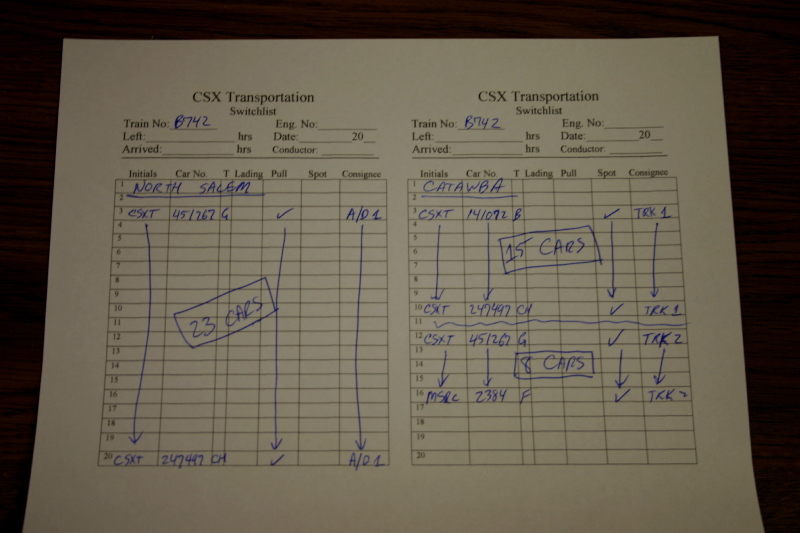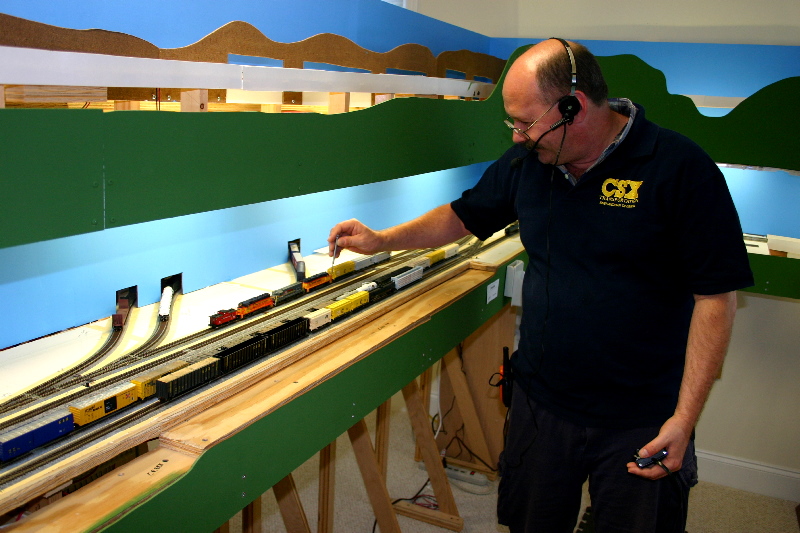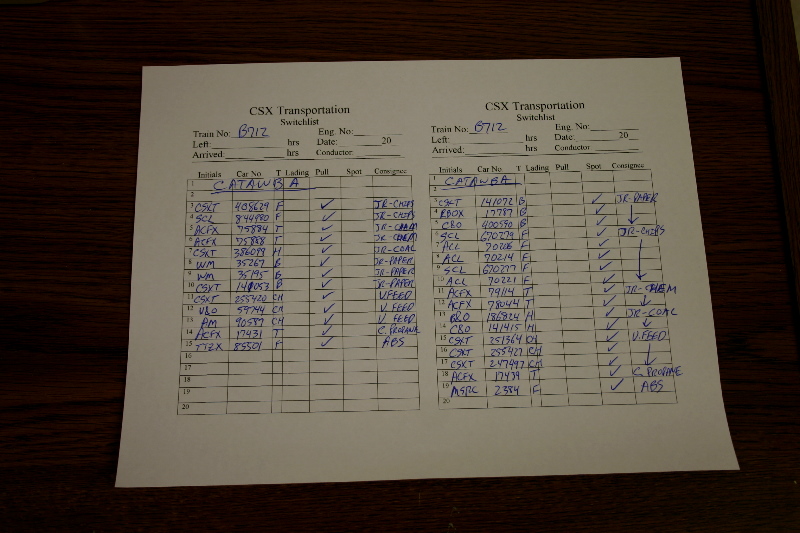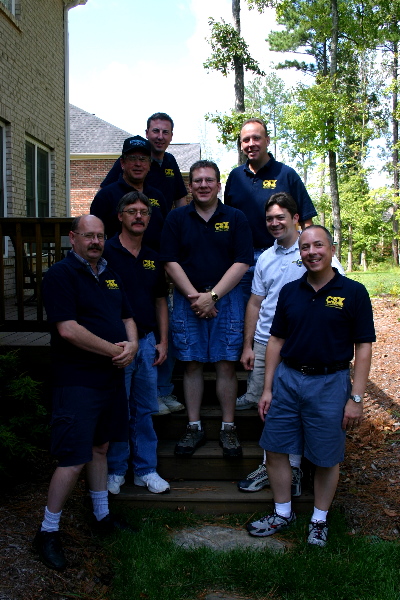|
Home
Up
| |
Highlights of the September 16, 2006 Operating Session
After a incredibly busy summer resulted in skipping the July operating session because
of scheduling conflicts, the CSXT Shenandoah Division came to life once again on
September 16, 2006. There were eight members (including me) of the operating
crew present. This session would be the second time operating the entire
Covington Subdivision (the majority of the layout) under TCS control.
The session started at 1:00 p.m. as usual with a briefing for the operating
crew. After emphasizing some changes in operating procedures and taking a group
photo (thanks to the Chief Operating Officer of the Crandic for the idea), we
started the session at about 1:30 p.m. We took our normal mid-session break of
about 30 minutes for some snacks and social time around 3:00 p.m., and then we
resumed operating around 3:30 p.m. before ending the session at 6:15 p.m. Well,
it was supposed to be our "normal" mid-session break, but as I was writing this
report, I realized we took the break earlier than at previous sessions, and I
began to wonder why. I then went to check my master LocoNet Fast Clock, and I found
that the rate had somehow been set to 4:1 instead of our usual 3:1, which
explains why we operated for 16 hours instead of our usual 12!
We continued the procedure introduced at the May 20,
2006 operating session to have only the crews for the initial two trains,
along with the Trainmaster, in the layout room at the start of the session. The
other crews remained downstairs in the "crew lounge" while we got the session
going. This procedure seems to alleviate some of the normal chaos at the
beginning of the session and will be continued as a normal practice at all
future sessions.
This session ran our normal "PM" sequence (1900 to 0700, except because of
the clock rate error, we actually ran to about 1130), with one new change: the introduction of our first shifter on the Shenandoah Division V2.
After exchanging ideas with a friend from the Operations SIG
earlier in the summer, I realized I shouldn't wait to start running the shifters
until I had time to create new car cards and waybills. He convinced me to go
ahead with some simple switchlists, and he sent me his switchlist form, which I modified so we could run our first shifter (train B712,
the Second Catawba Shifter) during this session.
With the new shifter, there were a total of 19 trains on the lineup sheet for
this session. We were able to get all 19 of the trains out on the road, and all
19 of them completed their run! Even with TCS, radio traffic increased somewhat
at this session because of the necessity of calling the dispatcher when needing
to make a local move through an OS section at the end of a passing siding. The
B712 shifter needs extensive use of dispatcher-controlled switches in order to
complete its work. Train B742 also needed to contact the dispatcher to set off
cars at Catawba for B712, while train R699 would contact the dispatcher when
making moves at Catawba to pick up cars from B712. A planned future change is to
install key switches and pushbuttons to allow the shifter crew to take the
switch "off power" when given Track and Time from the dispatcher.
In an eerie similarity to the events of the May 20, 2006
session, an Amtrak train stalled on Rich Patch Mountain in the Corkscrew.
Apparently, management decided to add some Material Handling Cars on the rear of
Amtrak P051, the westbound (albeit northbound on the Shenandoah Division)
Cardinal without adding additional power. As a result, the train stalled
coming out of Rich Patch Tunnel, just north of the intermediate signals in Rich
Patch, Va., where the grade is about 2.3% and before the short stretch of 2.8%
at the top of the Corkscrew. Southbound "Juice Train" K657 was in the siding at Laurel waiting to
meet P051, so the SD Dispatcher had K657 cut off their power to help P051 up the
mountain.
With the need to move cars to and from the yard at Catawba for B712, two
trains ran with record length at this session. Northbound B742 ran with 53 cars
from North Salem to Catawba, and southbound R699 ran with a whopping 55 cars
from Catawba to North Salem.
I served as Trainmaster for the entire session since we were running the new
shifter. I did not want to be distracted by running trains so I could focus on
any operational issues which resulted from introducing the B712 to the traffic
mix. Larry served as the B712 crew, and Marcus was once again our SD
Dispatcher. The two of them worked quite well together to handle this train in
spite of heavy traffic on the division. After the session, the three of us have
discussed some changes to implement at the next session to make the job work
better.
Jan, Dave, Jeff, Rich, and Rob rounded out the crew at this session. I
appreciate the participation of the entire crew in helping me achieve my vision
for each operating session!
|
|
September 16, 2006 Operating Session Photos |

Rob and Dave served as the crew of northbound Q694. Shortly after the start of
the session, they have their train in the siding at New Castle waiting for
southbound Amtrak P031 before Q694 can be pushed up Rich Patch Mountain.
|

Meanwhile, over in North Salem, Jan has made a pickup of 23 cars on B742,
giving his train a total of 53 cars! The 23 cars he picked up would be
set off in Catawba for B712, the Second Catawba Shifter. While Jan was doing
his work on B742, Jeff has brought
T466, an empty northbound hopper train, into North Salem.
This session marked the first time that the entire visible portion of the
lower level has add lighting installed. The crew members present all agreed
the lighting makes a huge difference in being able to see the action during
the session.
|

B742, with 53 cars, stretches from near the south portal of Hanging Rock
Tunnel almost back to SN Cabin, where the T466 waits to head north. B742 had
to run ahead of T466 in order to set off cars for B712, so the Second
Catawba Shifter could begin its work.
|

Jan brings B742 into the siding at Catawba in preparation for setting off
23 cars in the yard there. The power can be seen just to his left, while the
caboose on the rear of the train is still crossing the
Catawba Creek Viaduct.
|

Here's the switchlist Jan used for the B742, showing the cars to be
picked up in North Salem and set off in Catawba. I filled out the switchlist
prior to the session.
|

While B742 was working at Catawba, and after meeting Amtrak P031 at New
Castle, Dave runs the Q694 up Rich Patch Mountain with Rich serving as the
B265 pusher crew to shove Q694. Rob is enjoying watching
the action at the Corkscrew.
|

After B742 set off 23 cars into the two track Catawba Yard and left town,
Larry begins the work for B712, the Second Catawba Shifter. He has picked up
3 covered hoppers from Valley Feed before beginning to work the James River
Paper Mill.
|

The power for B712 has been cut off from the pickups at Valley Feed and
will start switching James River.
|

Here's one of the switchlists used for B712. This switchlist simply has
the Catawba work for this train, which also runs to New Castle and back.
|

The other switchlist for B712 contains its work for Abbott and New
Castle.
|

With an underpowered train, Amtrak P051 has stalled at Rich Patch. Rob
waits as Jeff has cut off the power from K657 to come down the mountain to
help P031 to Laurel.
|

After helping P031 to Laurel, Jeff got his power back on K657 (the
southbound "Juice Train") and continued down the mountain. He'll hold
the mainline for his meet with NS
freight Z351 at New Castle.
|

K657 is about to knock down the southward absolute signal at the north
end of New Castle for its meet with NS Z351.
|

K657 continues to make progress to Catawba, where it meets train B712. In
this view, B712 has previously made pickups from Valley Feed and James
River, and the shifter is now setting off cars at those two industries.
|

Congestion at Catawba: a three way meet is occurring here with B712 in
the yard, empty northbound hopper train V648, and southbound autorack train
Q243. Since he's going nowhere on B712 any time soon, Larry takes a break
while Jan runs Q243 and Dave waits for a signal for the V648.
|

B712 finished its local work in time for R699, the last southbound
merchandise train in the PM session sequence, to pick up 24 cars at Catawba.
When added to the 31 cars already in the train, R699 pulled 55 cars (a
record train length) into North Salem, where it would set off the 24 cars
picked up at Catawba.
Neither B742 nor R699 had any trouble operating between Catawba and North
Salem. The cars in these trains are equipped with low profile metal
wheelsets and a mix of truck and body mounted couplers. The trains ran
smoothly over the Atlas code 55 track.
|

Crew photo 09/16/06. Larry, Jeff, Dave, Marcus on the left, with Jan,
Rob, Rich on the right and Bruce in the center.
|
This page was last updated on
01/01/11.
|